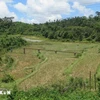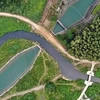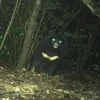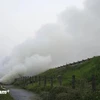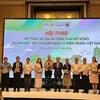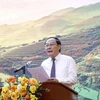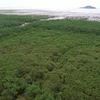 A grey-shanked douc langur in the Kon Plong forest in Kon Tum province (Source: Fauna & Flora International (FFI))
A grey-shanked douc langur in the Kon Plong forest in Kon Tum province (Source: Fauna & Flora International (FFI)) Hanoi (VNA) – After spending months surveying a forest in Kon Plong district, the Central Highlands province of Kon Tum, researchers from Fauna & Flora International (FFI) have discovered groups of rare primates which are considered a “treasure trove” of biodiversity.
The teams from FFI and the GreenViet Biodiversity Conservation Centre have also uncovered populations of imperiled species such as the grey-shanked douc langur, northern yellow-cheeked gibbon, Owston's palm civet, Asian black bear, pygmy slow loris, otter and wildcat.
Launched in 2016, systematic surveys of FFI have spotted about 500 grey-shanked douc langurs in Kon Plong and more than 100 northern yellow-cheeked gibbons, which are both highly threatened with extinction.
Intensive camera-trapping surveys, undertaken in partnership with the Leibniz Institute for Zoo and Wildlife Research (IZW), using 130 Panthera remote camera traps, have also recorded 121 mammal and bird species, including critically endangered and indigenous ones.
Notably, the population of the Owston's palm civet was found in surprisingly high abundance in areas of Kon Plong. This species of small carnivore, listed as Endangered by the International Union for Conservation of Nature (IUCN) and of international importance, has gone extinct or been seriously affected by snaring in most other places, including large national parks and nature reserves in Vietnam.
Moreover, Kon Plong is also home to nationally or regionally endemic bird species like the chestnut-eared laughingthrush, golden-winged laughingthrush and several endemic plants.
Taken together, these results identify the forest in Kon Plong as one of the most valuable areas for conservation, not only in Kon Tum, but in the whole of Vietnam and the wider region.
According to FFI, this natural heritage is truly a national treasure, and populations of animals and plants must be protected and allowed to recover here. The values are intrinsic, but are also profoundly important to people, with forests providing food, medicine, watershed protection, hydrological services, pollination, climate change mitigation (storage of carbon) and disaster risk reduction.
Whilst the results are undeniably good news, FFI said, there is an urgent need for forest protection. Significant threats to these forest areas include illegal hunting and logging, as well as deforestation and habitat fragmentation driven by large-scale agriculture, road building, hydro-dams and wind farms, over which forest protection authorities have no control.
Despite the significant efforts by law enforcement agencies in Kon Tum to control illegal hunting, there are still many cases in which animals such as pangolins, bears, primates and birds are targeted by professional hunters. Wildlife from Kon Plong is often traded to different provinces and cities, placing ever-higher pressure on the forest.
Conservationists believe that there is an urgent need for biodiversity conservation interventions, including civil society collaboration with the government. The highest priority now is to legally and actively safeguard one of Vietnam’s last great wild areas as a protected area.
With important information on biodiversity recently recorded, the Kon Plong forest deserves to be a valuable natural reserve in the Central Highlands. Besides, the benefits of nature protection, preserving this area will contribute to improving the value of sustainable tourism for Kon Plong, according to Director of PanNature Trinh Le Nguyen.
Currently, FFI and GreenViet are working with government partners and local communities towards establishing a new and effective protected area there.
This project is supported by the IZW, the Forest Protection Department of Kon Tum, local authorities and communities, and with funding from the Darwin Initiative of the UK Government, Rainforest Trust and Stiftung Artenschutz./.











